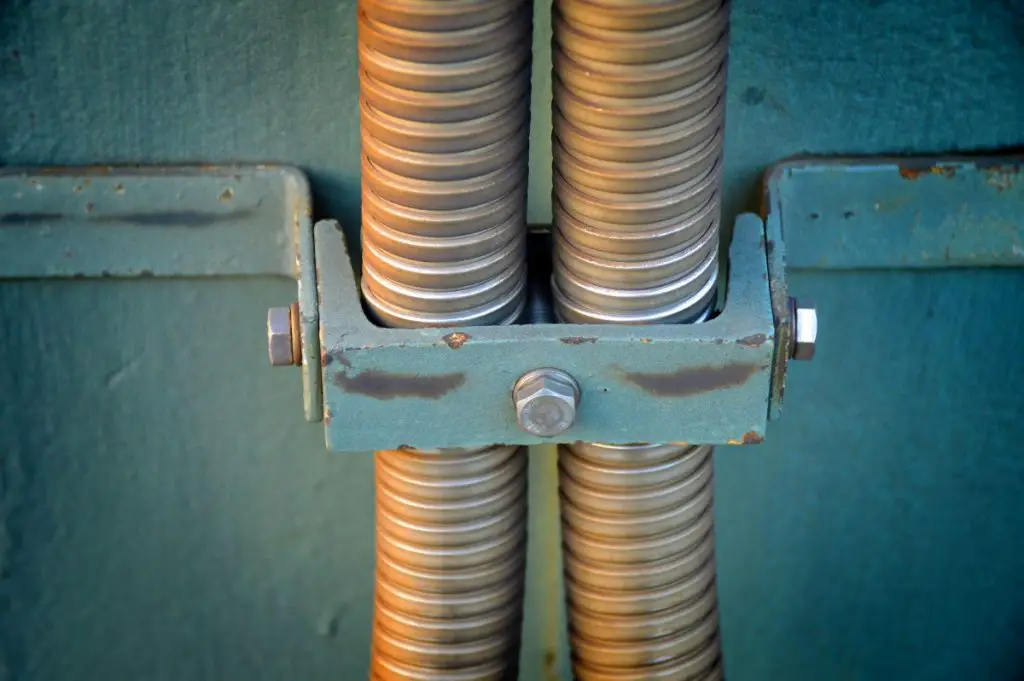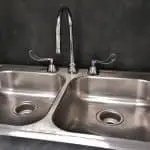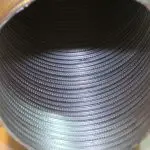
Choosing a PVC over cast iron pipe can give you huge benefits in terms of affordability and installation ease. Needless to say, PVC drain pipes are cheaper and easier to implement as a drainage system.
However, because this material is less dense compared to its iron counterpart, it does a poor job of covering up the swooshing sound of waste water in the drain. This means that PVC is noisy and, if the installation is not perfectly done, the pipe itself can be a source of more annoying noise. So, you’ll need to soundproof your PVC pipes, to reduce the sound.
Table of Contents
Soundproofing PVC Drain Pipes – What to Expect
Well, there is no single solution to this problem. In many cases, you won’t be able to totally eliminate drain pipe noise. In this post, I will be sharing with you a variety of effective ways to get at least some PVC drain pipe noise reduction.
It’s important to realize that not all of these strategies may work in your situation. The success, therefore, depends on many factors. These may include the density of the pipes, the location, etc. Of course, the cost of the solutions will vary as well.
1. Install the Pipe in a Less Disruptive Location
One of the best ways to ensure that you don’t hear water rushing through your PVC drain pipes is to install them in the right spot in the house. If the pipe system runs through the living room or your bedroom wall, you’ll probably hear the swooshing sounds. Of course, this is something to be dealt with when building a new home or putting in an addition – it’s not reasonable to relocate plumbing once the house is finished.
It may seem like common sense to not run drain pipes near a living space, but most of the time most homeowners really don’t think about it, or have no say in the matter. The simplest way to get rid of that possibility though is to install the pipe behind closet walls. The closet wall becomes the first line of defense against the annoying sound from the pipes.
If you are currently building the house, this strategy is perfect. Instruct your builder to position the pipes in a less disruptive location of the house (and verify it, if you can, before the drywall goes up).
You’ll probably want to request they apply some of the other strategies to control drain pipe noise, as well. But, those techniques will come later in the build process – after the plumbing is installed, but before the sheetrock is installed.
But if you are living in an apartment or rental house where everything is installed, I’m afraid this strategy won’t work for you. Rarely are tenants are allowed to make permanent modifications to the existing structure of the apartment unit.
2. Use Two Types of Drain Pipe Material
Generally, there are two types of drain pipe material: cast iron and PVC pipes. We know that cast iron drain pipes are more durable, thicker, and quieter than PVC pipes. However, iron pipes are more expensive than PVC, so cast iron is not the standard any longer.
Obviously, you cannot get all the features – low cost and soundproofing – you want from one type of pipe. You will more likely end up picking one over the other.
However, in terms of reducing the sound of the draining pipes, I suggest that you combine the two. You can use both types of materials in your draining system at the same time, mixing and matching, as appropriate.
What you can do is install each pipe type in specific locations. Because iron pipes are a lot quieter than the PVC, you can use them behind your living room or bedroom wall. That way, you won’t be disturbed by the swooshing sound.
Then use PVC pipes in the remaining areas in the house, where noise is a less important consideration.
Using this strategy will not only allow you to save money, but also save effort on your part. This is because PVC pipes are easier to install and cheaper, while cast iron costs more, but dampens sound very well.
I should mention that in all the discussions I’ve been privy to, the unanimous opinion is to just use cast iron pipes in the first place, wherever possible. Of course, this is best implemented when you’re building a new home, putting in an addition, or renovating. You can swap out sections of pipe after the fact, but that’ll require you to rip out, then replace, drywall. Hint: it may well be worth it. It’s a permanent solution, and much more likely to be effective than the cover-up solutions.
3. Insulate PVC Pipes with Soundproofing Materials
The first two pipe soundproofing techniques I mentioned above may not always work. This is the case when you don’t want to change anything significantly, or when you can’t change the plumbing itself.
The only thing you can do in this case is to use sound-dampening insulation. There are soundproofing materials you can use to insulate the pipes. This process is much easier and quicker compared to other drain soundproofing techniques.
A very inexpensive pipe soundproofing wrap
The easiest way to do this is to coat the PVC pipes with soundproofing material designed for this purpose. My recommended material is the Self-Adhesive Pipe Insulation Soundproofing Barrier Foil Mat. It’s a very quick process to wrap this insulation around the pipe.
If you have a noisy PVC pipe installed through your bedroom or living room wall, this material is a great solution. This is not only great for soundproofing but also for thermal insulation.
What I like the most about this material is its self-adhesive feature and easiness to cut in sizes with a knife or other household tools. And because it is self-adhesive, you just need to stick it on the area you want to soundproof.
In worse noise scenarios, one layer may not be enough. But don’t worry, you can add more layers until the disturbing swooshing sound disappears considerably. Or, consider a heftier pipe soundproofing solution, which we discuss below.
Another great thing about this insulating mat is that it is not only designed for soundproofing pipes, but also for other soundproofing projects. You could also use this insulating mat in your car or around the house. If you have a weak spot in your house that allows too much noise to enter, this mat can supplement to create a thicker sound barrier system.
Another quick and inexpensive sound blocking solution
Another easy great way to quiet a drain pipe is to coat it with Insulating Foam Sealant. This is another handy material you can apply to quickly solve your drain noise problem, as well as other noise-related problems.
All you need to do is to spray this insulating foam on the areas you want to soundproof. Then the foam hardens as soon as it comes out from the container. And when it does, it becomes really thick and dense, providing a great sound barrier.
The great thing about this material is that it’s easy to apply regardless of the surfaces and nature of the pipe.
If you want to use this type of material though, make sure that you pick the right brand. This is because not all Spray-On Insulating Foams are great. Other brands do not provide good results. So, check the reviews!
In fact, I’ve tried the lesser quality sprays before. Of course, the result was frustrating. I noticed bubbles all over when I was spraying. As the foam hardened, hollowed sections formed. It was definitely not a good soundproofing experience.
The one I recommend above really worked for me. so I stick with it. You can find the same brand with the same or better quality. All you need to do is to do a little bit of research before buying the product.
Perhaps the ultimate wrap for quieting noisy PVC pipes
Another great option recommended by experienced handymen is Dynamat Xtreme Thick Self-Adhesive Sound Deadener. As it’s name says, it comes with adhesive, so you don’t need to worry about getting it to stick. It’s actually made for soundproofing cars, so the adhesive should be super reliable. And, yes, it’s been tested on PVC drains, and works fine. Our handyman just said to be sure the PVC pipe is clean and dry before you start. I’ve seen this particular recommendation among handmen and building contractors quite a lot.
A heavy duty DIY solution to soundproofing “wrap” for pipes
Another very effective way to soundproof your PVC pipes is using Mass Loaded Vinyl (aka MLV). You’ll see this material discussed wherever soundproofing materials are mentioned, because it’s so versatile. It’s basically a (somewhat heavy) vinyl sheet, that you cut to size and wrap around the PVC pipe, in this case. It isn’t self-adhesive like the pipe insulation soundproofing barrier we mentioned above, so you’ll need to tape or glue it into place. Mass loaded vinyl is relatively heavy, and PVC pipe is fairly slick, so your choice of adhesives is important.
Our sources in the handyman world suggest Power Grab, a construction adhesive, along with zip ties. Experts recommend that you overlap the edges 1 to 4 inches (4 inches is better), so sound doesn’t leak out the gaps. (Sound will leak out any gaps.) They also recommend that you caulk the overlaps. (There’s that Green Glue again.)
4. Add Another Drywall – a Last Resort?
If all else fails, and/or you can’t actually get to the pipes themselves – a likely scenario – you can either rip out the drywall to wrap the pipes, or add another layer of drywall on top. (Drywall is actually a very good sound insulator.)
If you’re ripping up the wall anyway, you may want to seriously consider just replacing the section of PVC with cast iron – it’s a better solution all around (although more expensive, because now you’re probably involving a plumber).
If you do opt to just add another layer of drywall on top of the existing drywall, be sure to put in a layer of sound insulation, like Green Glue, between the two layers of sheetrock.
The obvious drawback of this process is its price. Adding drywall to the existing wall is pricey and usually requires a professional to do so. But if this is the ultimate solution, then you should probably consider this option.
Final Thoughts on How to Soundproof PVC Pipes
The right solution for you will depend on the severity of the problem, whether you own or rent, and your budget. Certainly the easiest and cheapest fixes are those that can be applied directly to accessible pipes. The very best solutions require more extensive work, and far greater expense.
I’d recommend you try the cheap and easy fixes first, and see how that works.
If all the tips I shared here did not work, then replacing the PVC pipe with cast iron pipe is always an option – although a very labor-intensive, and therefore expensive, option.
Related Question:
What is the difference between a waste pipe and a drainpipe? Technically, these are the same drainage systems. The difference between the two is their main function.
A waste pipe generally drains human waste. This pipe system is commonly installed in residential buildings. A drainpipe, on the other hand, only drains rainwater. This pipe system also common in residential buildings and factories.
To learn more about soundproofing, read my Soundproofing Guide.




